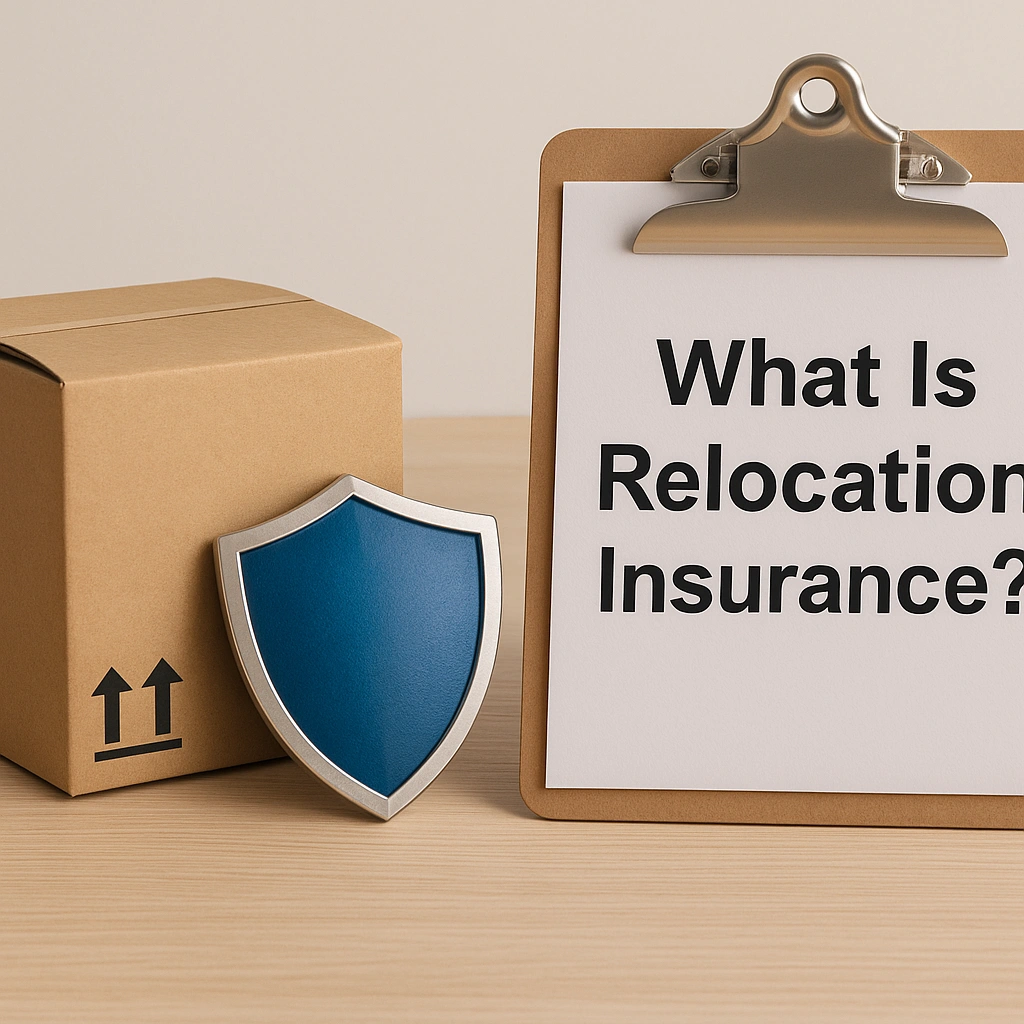Moving overseas feels exciting until you realise your furniture might not make it to your new home in one piece.
Your possessions spend weeks travelling between countries, and anything can happen during that phase. Trucks can break down on busy roads, storage warehouses sometimes flood, and shipping containers get rough treatment at sea.
These problems happen more often than you think. This is where relocation insurance becomes important, and it gives you peace of mind that your belongings are protected during this vulnerable time.
In this article, we’ll show you how shipping protection works and help you choose the right insurance cover for your move to your new home.
First, let’s go over what relocation insurance is.
What Is Relocation Insurance?

Relocation insurance is specialised insurance cover designed to protect your belongings during an international move. It steps in when your possessions get damaged, lost, or stolen while travelling to your new home.
This protection covers several common risks that happen during overseas moves, including:
- Accidental damage from rough handling
- Theft from storage facilities
- Environmental factors like fire or flooding
Some coverage also protects against humidity damage and other weather-related problems.
How It Differs From Contents Insurance or Travel Insurance
It’s useful to understand how insurance differs from contents or travel.
Your regular contents insurance only works while your belongings stay inside your house. Once your furniture leaves your old home, the policy stops covering your possessions. Similarly, travel insurance focuses on personal items you carry with you, which don’t cover household goods.
Relocation insurance fills this gap by protecting your shipped items during the entire moving process.
Types of Cover You Can Choose
Now let’s break down the main types of cover available to help you choose what suits your circumstances.
First is transit insurance, which protects your belongings while they’re on the move. This includes protection during transport by ship, rail, and road. Most international moves involve multiple transport methods, so this coverage follows your items through each stage.
Next, storage insurance covers your possessions when they sit in warehouses between transport stages. Many overseas moves require temporary storage, especially if your new home isn’t ready yet.
You can also choose between different policy types. Then there’s the all-risk coverage, which protects against most types of damage to your belongings.
Total loss policies, on the other hand, are cheaper but only pay if your items are completely lost or destroyed, since they don’t cover partial damage.
What Gets Covered and What Doesn’t
Now, most policies cover accidental damage and theft during normal transport (you don’t need to worry about it). But what you want to watch out for are poorly packed, electrical items without special handling, and certain fragile goods. Insurers may not cover them unless they’re declared.
Now, let’s look at the specific details you need to check when choosing a policy.
What to Look for in an Insurance Policy (and What Most People Miss)

Most people pick the first relocation insurance policy they see without reading the details. This often leads to unforeseen problems when they actually need to make a claim.
So we recommend reading through the following before choosing a policy. It can save you both money and headaches.
Key Terms You Need to Know
First, let’s look at some basic terms that appear in every policy.
A deductible is the amount you have to pay before your insurance policy starts helping. A lower deductible costs more each month, but it saves money if something goes wrong with your move.
Exclusions are equally important to understand. These are the things your insurance won’t pay for. And this section usually contains surprises that could leave you without help when you need it most.
You’ll also see salvage value mentioned in many policies. This means what your damaged items might still be worth after an accident. Some insurance companies reduce how much they pay you based on this leftover value.
One thing you absolutely want to watch out for is subject to conditions, which means your coverage only applies if you follow certain rules. Make sure you know them before agreeing.
Hidden Exclusions to Watch For
Now, there are still some exclusions that can catch you off guard. Many policies, for example, don’t cover damage from mould or humidity, especially during long sea journeys. Items damaged due to poor packing are often rejected, too.
Another common problem is that delays from customs issues rarely get covered. Even if these delays cause extra storage costs, most policies won’t pay for them.
Transport Protection
When it comes to actual transit protection, different shipping routes have different levels of risk. Some countries have higher rates of theft or damage, which affects both your costs and what coverage you can get.
For example, air transport usually protects your belongings better than sea or road transport. However, flying your items costs more money and has weight limits that might not work for big household moves.
Weather and timing play a role, too. Moving during storm seasons or busy shipping times increases your chances of delays and damage to your possessions.
When to Use an Insurance Broker
If all this seems overwhelming, consider working with an insurance broker. They help you compare different policies and explain complicated terms in plain English. This is especially helpful for expensive moves or when you’re shipping items to countries with tricky rules and regulations.
But things can still go wrong during a move, and handling claims correctly can save you from months of disputes.
What to Do If Something Goes Wrong: Claims, Disputes, and Delays

When things go wrong during your international move, it’s normal to feel lost and overwhelmed. But don’t worry, here’s exactly what you need to do when problems happen with your move.
How to File a Claim the Right Way
The first thing to remember is that time matters when filing claims, so you’ll need to act quickly. Most insurers want you to report damage within 7 to 14 days after your items arrive. This means you should contact your insurance company right away, even if you’re still unpacking boxes and finding new problems.
Next is getting your claim approved, which depends on having the right paperwork ready. Start with photos of any damage, as they provide the strongest proof. We also advise having your original inventory list and delivery receipts ready to support your claim.
Pro Tip: Keep all the packaging materials until your claim gets sorted out. These boxes and wrapping often show exactly how the accidental damage occurred during transport.
What to Do in Different Problem Situations
Like we said, things don’t always go according to plan when moving. But these tips will show you how to deal with the most common issues.
When your items arrive damaged
The goal here is to leave everything as it is and take photos first, so you have solid proof for your claim. Start by documenting how the packaging looks, then photograph the damaged items from several different angles.
When you find damage weeks later
Now, don’t panic if you find problems after unpacking. You should report the issue as soon as you notice it, since many policies allow claims for hidden damage that wasn’t obvious at first.
When your claim gets rejected
If your claim gets denied, ask the company to explain in writing why they turned it down. Then you can review your policy and gather any extra evidence to support your case if you think the denial was unfair.
Understanding Salvage Charges
Now let’s talk about something that confuses many people: salvage charges. These can reduce how much money you get from your claim because they apply when your damaged items still have some value left.
For example, if your dining table gets scratched during the move but still works fine, the insurer might pay you less. This happens because the damaged table is still worth something, even though it’s not in perfect condition anymore.
Dealing With Disagreements
Sometimes you won’t agree with what the insurance company decides about your claim. When this disagreement happens, start by asking to speak with a supervisor or manager who might have more authority to help.
Throughout this process, make sure to write down what everyone says during phone calls and keep copies of all emails and letters.
If the problem gets too complicated to handle alone, that’s when you might want to consider asking an insurance broker to help you work through the dispute.
A Smarter Move Starts with the Right Protection
You wouldn’t dream of moving overseas without proper health insurance or travel coverage. So why would you ship your most precious possessions without adequate protection? The risk simply isn’t worth taking.
So, take time to decide what matters most to you before you start packing. Be it family heirlooms, pricey electronics, or even regular furniture, make sure your insurance policy covers these items properly.
When you have the right protection, you can look forward to your overseas adventure without fear of something happening to your belongings.
Find the right plan for your move at Gooferman and keep your things safe.
